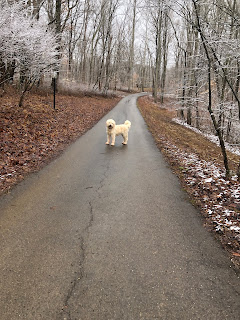Approximately eight years ago Kalee, my daughter and her husband Will were looking for a special project for a Mother’s Day gift. They had been staying with us for a couple weeks and realized how overwhelmed I was with the scope of constant work involved with the upkeep of my gardens.
One of the most expensive items, plus the most time consuming task during my early days of managing my 6 acres of gardens and land, was controlling the weeds by mulching. I began out of desperation to explore creating alternatives such as using green living mulch under big areas, so I did not have to buy and spread mulch each season.
This area under the large Siberian Elm which required a lot of mulch was a prime example. I was in need of a spot to let one of my favorites Lilly of the Valley plants run wild and the space under this enormous tree was perfect. Kalee and Will made it happen by transplanting a hundred or more Lily of The Valleys to the space under the tree. They took them out of a perennial garden where they were invasive and placed them under the tree where they could grow, protect the Siberian Tree roots and sing joyfully.
Flash forward to May 2020, and the space has filled in beautifully. As I worked in the space today I could smell the amazing fragrance calling out to me. The Lily of Valleys are so thick that they block out most weeds. This time of year they spew forth such a sweet scent and have a very unique display of small white bells. Even after they are done blooming the dark green foliage remains a soft carpet under my massive tree.
As a child my mother and grandmother always had this plant in our gardens. They would send me out to pick them and then sing to me the following song:
White coral bells upon a slender stalk,
Lilies of the valley dress my garden walk.
Oh, don’t you wish that you could hear them ring?
That will happen only when the fairies sing…
Last night as I picked these little gems, weeded and edged the area, I heard the fairies singing and ringing the bells. I definitely felt my mom and grandma’s sprite with me. What a great pre Mothers Day evening in the garden…thank you fairies!
Facts about Lily of the Valleys:
From “Gardening Know How”
Growing Lily Of the Valley: When To Plant Lily Of The Valley
Around since at least 1000 B.C., lily of the valley plants are one of the most fragrant blooming plants in the spring and early summer throughout the northern temperate zone.
The stems are covered with tiny white, nodding bell-shaped flowers that have a sweet perfume and medium-bright green leaves that are lance-shaped, 4 to 8 inches (10-20 cm.) high and 3 to 5 inches (7.5-12.5 cm.) wide.
This moisture-loving plant forms a spreading mass with red seed pods remaining after flowering, which makes lily of the valley attractive after blooming and very carefree. Growing lily of the valley plants (Convallaria majalis) is easy, as they will remain perennial in USDA Zones [1]2-9.
Growing Lily of the Valley
This easy-care plant doesn’t require much to thrive. Preferring partial shade [2] and moist soil, growing lily of the valley is easy if you know how and when to plant. That being said, these plants are adaptable and will grow very well in dry shade too. Lily of the valley can also be adapted to full sun or full shade, depending on the amount of moisture it receives.
When purchasing plants, look for the following cultivars:
• Convallaria majalis ‘Albostriata’ – This type has dark leaves with white to cream longitudinal stripes.
• ‘Aureomarginata’ – This variety has cream to yellow-edged leaves.
• Rosea – A pink variety, not as vigorous as the white-flowered species but very pretty.
• Convallaria majuscule ‘Greene’ – This North American native is great for naturalistic ground cover and provides a carpet of beauty between other native plants.
When to Plant Lily of the Valley
Knowing when to plant lily of the valley will help to ensure its survival in your garden. Planting lily of the valley should take place by late fall. Cool winter temperatures are required to allow a proper dormancy period [3].
The single underground rhizomes of this plant, which are known as “pips”, can be divided anytime after flowering. November or December would be the ideal time for division [4] and planting lily of the valley. Care should be taken when planting as it is a poisonous plant, so keep it away from children and pets.
Try planting lily of the valley plants in a naturalistic garden. Planting lily of the valley in outdoor containers would also be a great way to control its spread and provide it with the moisture it enjoys.
No matter what method you choose for growing lily of the valley, you will find that lily of the valley care is easy and worth the rewards.
Article printed from Gardening Know How: https://www.gardeningknowhow.com
URL to article: https://www.gardeningknowhow.com/ornamental/bulbs/lily-of-the-valley/growing-lily-of-the-valley.htm
URLs in this post:
[1] USDA Zones : https://www.gardeningknowhow.com/planting-zones/usda-planting-zone-map.htm
[2] partial shade: https://www.gardeningknowhow.com/garden-how-to/info/what-is-partial-sunlight.htm
[3] dormancy period: https://www.gardeningknowhow.com/garden-how-to/info/plant-dormancy.htm
[4] division: https://www.gardeningknowhow.com/garden-how-to/propagation/propgen/dividing-plants.htm
Have any questions about this topic? Visit us at https://questions.gardeningknowhow.com to ask your questions and get friendly answers from gardening experts.
You can also find us at:
'Like' us on Facebook: https://www.facebook.com/gardeningknowhow
Follow us on Twitter: https://twitter.com/gardenknowhow - @gardenknowhow
Follow us on Pinterest: https://pinterest.com/gardenknowhow/
Copyright © 2020 Gardening Know How. All rights reserved.

































